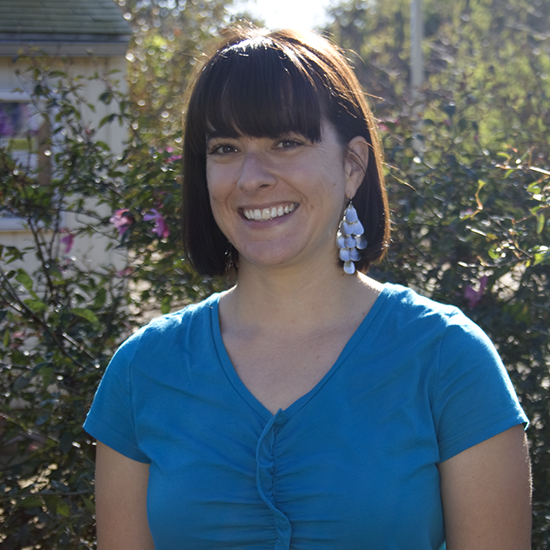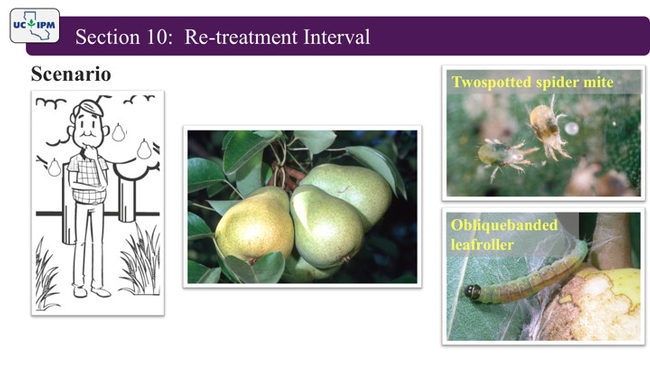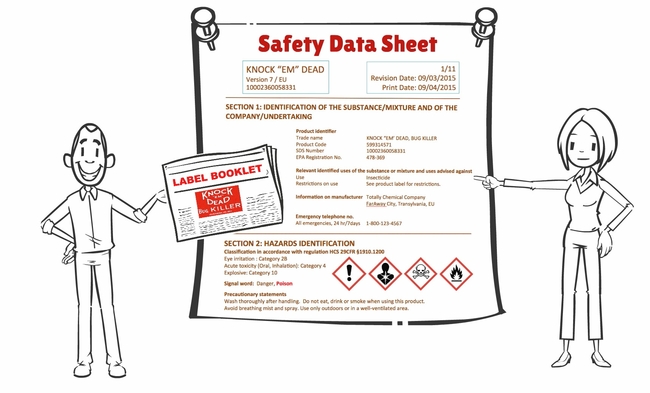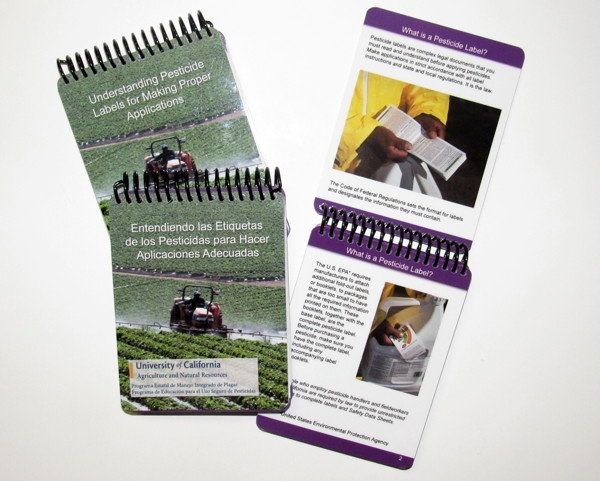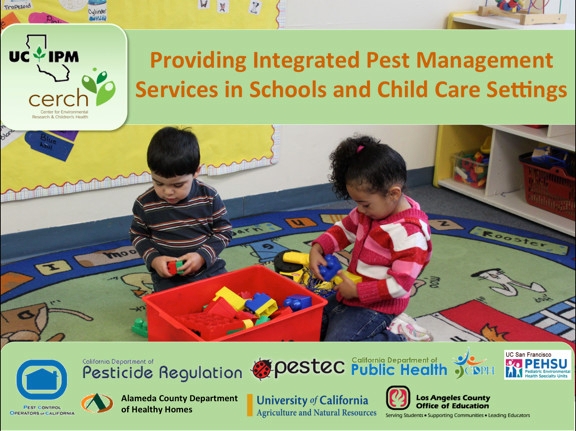Posts Tagged: pesticides
UC ANR pesticide safety trainer reaches thousands of California farmworkers
"I love it when they say, ‘You've taught me something new.'” When Lisa Blecker hears these words from workshop participants, she says it is one of the greatest satisfactions in her role as a pesticide safety education coordinator with the UC Integrated Pest Management Program. She enjoys teaching people how to see their surroundings differently when it comes to working with pesticides.
"Participants who have spent years in the profession often say, 'I've been doing this forever, and I had no idea that my gloves had to be 14 mils thick,'" Blecker said.
At the end of their workshops, webinars, or in-person training, all the participants fill out a survey and the results are positive: 93 percent of last year's participants indicated plans to make a change in workplace safety as a result of attending the workshops. The results also indicate that as many as 62,901 fieldworkers and 12,071 pesticide handlers will be trained in pesticide safety by participants from these workshops.
Training keeps Blecker busy. Half the year, she and her team travel across California to conduct workshops that provide pesticide safety training for commercial and private pesticide applicators. She works closely with the California Department of Pesticide Regulation to promote, through testing, the basic competency requirements for applicators.
“We write the study material that helps them pass the test. We help people through our study guides to get occupational certifications or, in some cases, a license," Blecker said.
What also makes Blecker proud is the fact that she delivers her pesticide safety workshops in Spanish in addition to English.
"I think it's critical for a pesticide safety program, and many outreach programs in this state, to deliver the message in Spanish because so much of the agricultural and even the non-agricultural workforce around pesticides are native Spanish speakers," she said.
Blecker emphasizes the importance of the workshops in Spanish for on-farm applicators. Their education on safe pesticide use and decision-making has the potential to impact as many as 829,300 farm laborers across the state working in the vicinity of on-farm pesticide applications.
"Many of these laborers are Spanish-speakers, which further underscores the need for community education in Spanish; it is easier to deliver technical content in Spanish if you previously received that information in Spanish," Blecker said.
She learned Spanish many years ago in Panama during her time in the Peace Corps. There, she provided community outreach to regional farmers through agricultural education and has been proud ever since to utilize the skill that opened many doors in her profession. Her first experience educating the public on pesticides was in Idaho, where she learned the value of being bilingual.
"I had the privilege to work with the pesticide safety program in Idaho where there was a need for Spanish language delivery. I love speaking Spanish which helps me connect with the language even more because I also get to pair it with my love for education," Blecker said.
With workshops in communities near the border with Oregon to the border with Mexico, Blecker has a vast area to cover. And that is only one of the many services her department provides. Another service is offering courses in continuing education for those interested in maintaining a license to apply pesticides. The licenses must renew every two or three years.
In 2019 alone, Blecker taught 34 in-person continuing education programs to a total of 1,987 applicators across the state who already hold licenses. Some of the topics include proper selection and use of personal protective equipment, respiratory protection, and safe use of pesticides in the landscape. A pesticide safety educator on her team delivered 10 similar programs to an additional 1,275 applicators last year.
"We also provide statewide train-the-trainer workshops because the U.S. Environmental Protection Agency and the California Department of Pesticide Regulation require certain people to go through an approved train-the-trainer program, so they can, in turn, provide pesticide safety training to field workers and pesticide handlers.
“We are approved by both the US EPA and by the Department of Pesticide Regulation to provide this curriculum," Blecker said.
She attributes the success of her department to the passion and hard work of her staff.
"I am proud of my program, but I'm very well aware of the fact that I can't run this extensive program on my own and I depend on my valued and talented staff," Blecker said.
She and her team promote the economy and a better lifestyle for all Californians, embodying the true nature of UC Agriculture and Natural Resources public values.
Blecker envisions a new direction for her department, one that will benefit even more Californians.
"I would love to follow that model where we work with employers to create policies that contribute to a safe workplace because it's not enough to just train people to do their job or to train them to keep their licenses," she said.
New online course helps growers prevent illegal pesticide residues
Last month, a California grape farmer was fined $10,000 for using a pesticide in violation of the label, then packing and attempting to sell the tainted fruit. DPR detected the residues of a pesticide on the produced that was not registered for use on grapes.
Cases like this are rare in California but remind growers how important it is to apply pesticides correctly by following all pesticide label directions. The California Department of Pesticide Regulation (DPR) runs the most extensive Pesticide Residue Monitoring Program in the nation and is hard at work ensuring that the fruit and vegetables we purchase and consume are free from illegal pesticide residues.
Understanding and following label instructions is the focus of a new online course developed by the University of California Agriculture and Natural Resources Statewide Integrated Pest Management Program (UC IPM).
The program, Proper Pesticide Use to Avoid Illegal Residues, is targeted to those who apply pesticides or make pesticide recommendations. It explains what pesticide residues are, how they are monitored, and highlights important residue-related information from several sections of pesticide labels. In addition, the course identifies the following as the most important factors leading to illegal residues:
- Using a pesticide on a crop for which it is not registered
- Applying pesticides at an incorrect rate
- Ignoring preharvest intervals, re-treatment intervals, or plantback restrictions
Course participants are presented with several real-life scenarios. They must search through actual pesticide labels to determine if the scenario illustrates proper use of pesticides or if the described situation could potentially lead to illegal residues.
The overall goal of this course is to have participants follow pesticide label instructions when they return to the field. Following the label can eliminate incidences of illegal pesticide use.
Proper Pesticide Use to Avoid Illegal Residues is published just in time for pest control advisers and pesticide applicators who are still a few units short to renew their licenses or certificates with DPR. The course has been approved for two hours of Pesticide Laws and Regulations continuing education units (CEUs) from DPR and costs $40. If you don't need CEUs, but are still interested in viewing the course content, check it out for free on YouTube.
DPR recommends that renewal packets be submitted before Nov. 1 in order to receive your renewed license or certificate by Dec. 31, as the processing time can take up to 60 days. For additional online courses that UC IPM offers, visit the online training page.
Follow pesticide labels to prevent illegal residues
As consumers, we put a lot of care into the food we buy. We tend to trust that the produce we purchase at the local grocery store is free of pesticides and safe to eat.
Traces of pesticide residue are normal and even expected after pesticides are applied to food crops, but by the time produce is ready to be sold, purchased, and consumed, residues are usually far below the legal limit.
In its latest report from 2013, the California Department of Pesticide Regulation (DPR) reported that there was little or no detectable pesticide residue in 97.8 percent of all California-grown produce. This demonstrates a strong pesticide regulation program and pesticide applicators that apply pesticides safely and legally. However, there have been instances in California where a pesticide not registered for a specific crop has been used unintentionally, resulting in illegal residues and eventually crop loss and destruction.
The Environmental Protection Agency sets tolerances for the maximum amount of pesticide residue that can legally be allowed to remain on or in food.
DPR regularly monitors domestic and imported produce for pesticide residues and is considered the most extensive state residue-monitoring program in the nation.
The primary way pesticide applicators can assure that they make proper applications and avoid illegal pesticide residues is to follow the pesticide label. The UC Agriculture and Natural Resources Statewide Integrated Pest Management Program (UC IPM) put together a 26-page card set in English and Spanish on understanding pesticide labels. Although intended primarily for pesticide handlers, applicators, safety trainers, and pest control advisers, these cards can be useful for anyone who applies pesticides in urban or agricultural settings. The cards explain when to read the label, describe what kind of information can be found in each section of a pesticide label, and point out specific instruction areas that will help applicators apply pesticides safely and avoid illegal pesticide residues.
To download copies of the card set in English or in Spanish, see the UC IPM web site.
Author: Cheryl Reynolds
Online course helps control pests, protect children
Free UC IPM course helps pest management professionals understand the Healthy Schools Act and provide IPM services to schools and child care centers
Pest management professionals can learn about the requirements of California's Healthy Schools Act by taking a free online course provided by the UC Statewide Integrated Pest Management Program (UC IPM), part of University of California Agriculture and Natural Resources (UC ANR).
To minimize children's exposure to pesticides, California requires pest control operators providing services in schools and licensed child care centers to comply with a series of laws called the Healthy Schools Act. The laws promote integrated pest management (IPM) in public K–12 schools and licensed private child care centers.
The free course Providing Integrated Pest Management Services in Schools and Child Care Settings explains what the Healthy Schools Act requires of schools, child care centers and pest control companies when managing pests in these environments.
"Taking the online course makes it easier to understand and comply with the laws," said Andrew Sutherland, UC ANR Cooperative Extension IPM advisor. "Pest management professionals can take the course at their convenience. It tells them everything they need to know about the Healthy Schools Act and IPM in order to do business with a school or child care center."
The course also includes a section on how companies can prosper by incorporating IPM principles and practices into their businesses.
"This is an opportunity for operators to take their businesses to the next level by adopting IPM practices," Sutherland said. "IPM effectively and efficiently manages pests, builds professionalism within providers, and captures value for the customer while minimizing pesticide applications, pesticide exposures and associated negative impacts on children's health, the environment and the larger community."
Licensed pest-management professionals can receive continuing education units by completing the online course: one "Rules and Regulations" and one "IPM" from the Structural Pest Control Board; and one "Laws and Regulations" and one "Other" from the Department of Pesticide Regulation.
UC Berkeley's Center for Environmental Research and Children's Health is developing a database of individuals who complete the course so that schools and child care centers can connect with pest control providers who are familiar with IPM and the Healthy Schools Act.
The training module was developed by Sutherland and collaborators at UC Berkeley and UC San Francisco, with input from California pest management professionals and child care providers.
To take the free Providing Integrated Pest Management Services in Schools and Child Care Settings course, see the UC IPM website http://ucanr.edu/ipm4schools.
This project was funded by the California Department of Pesticide Regulation Pest Management Alliance Program. For more information about the Healthy Schools Act, visit the California Department of Pesticide Regulation's School IPM web page http://apps.cdpr.ca.gov/schoolipm.
An initiative to maintain and enhance healthy families and communities is part of the UC Agriculture and Natural Resources Strategic Vision 2025.
Residential runoff still contains banned chemicals
Pesticides that have not been sold at the retail level for years are still regularly found in residential runoff water, according to research in Sacramento and Orange counties by UC scientists. So called “legacy pesticides” are probably old products that homeowners still have on their garage shelves and are still using to control pests.
An earlier study by the California Department of Pesticide Regulation and the UC Integrated Pest Management Program found that 60 percent of pesticides sold to consumers are for ant control. For that reason, UC Cooperative Extension specialist in landscape horticulture Loren Oki of UC Davis and UC Cooperative Extension water resources/water quality advisor Darren Haver focused on ant control pesticides in their residential runoff research project. The scientists collected 830 water samples from the storm drains in four Sacramento County neighborhoods and four Orange County neighborhoods between 2006 and 2010.
“In Sacramento County, we trained a team of about 25 volunteer UC Master Gardeners to collect the samples,” Oki said. Orange County samples were collected by Haver and his staff. All the samples were sent to UC Riverside for analysis.
“Pesticides that have been off the market since 2004 are still found in the water,” Oki said. “We found organophosphates – diazinon and chlorpyrifos – in differing amounts, typically more in Orange County than Sacramento County. We also found a fairly new pesticide, fipronil, in most of our water samples.”
The scientists also noted random spikes in the amount pesticides in runoff water, unconnected with storms or other conditions, which suggested that they were directly associated with particular pesticide applications in the neighborhoods.
There are several ways homeowners can help prevent contamination of the California water supply. For one, dispose of old pesticides properly. Most cities and counties have programs for disposal of household hazardous waste.
When using pesticides, Oki suggests residents carefully read the label and use common sense.
“Don’t put pesticides on impervious surfaces, like concrete walkways and driveways,” he said. “Don’t put pesticides in garden areas where runoff might be generated. That runoff will carry the pesticides with it.”
Residents can also minimize the amount of water runoff from the property. Oki suggests reducing irrigation and targeting the water application properly. In addition, promote soil infiltration by promoting soil health.
“If you don’t generate runoff, you won’t have pesticides running off too,” Oki said.
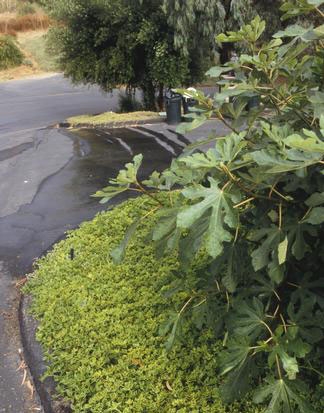
Residential runoff can convey pesticides into water supplies.

